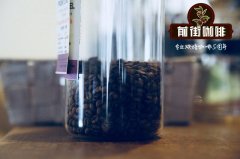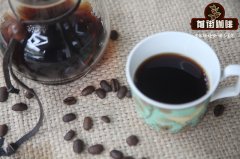What is Pacamara Coffee beans, Pacamara Manor, Pacamara Flavor

Professional coffee knowledge exchange More coffee bean information Please pay attention to coffee workshop (Weixin Official Accounts cafe_style)
Guatemala is definitely a blessed place. Guatemala has more than 300 microclimates throughout its territory, one of the most in the world, which is why few places in the world can produce as many high-quality coffee beans as Guatemala. At the same time, the volcanic terrain at high altitude provides the most ideal place for coffee cultivation. Rich nitrogen, abundant rainfall and sunshine make coffee rich in flavor and taste.
Guatemala's famous eight producing areas produced high-quality coffee beans, taste and quality are impeccable, and each has its own regional flavor, which is also related to the water and soil of the eight producing areas. Among them Antigua, Aikatango Valley, Etilan, San Marco, Huaiqiang Si, these five areas belong to volcanic rock geology. The three producing areas of Vivienne Nango, Cobain and New Oriental belong to non-volcanic highland or tropical rainforest climate.
Vivetnam fruit region enjoys a prestigious coffee estate-Inchter Manor
Find out where Pacamara comes from. Pakamara is a hybrid, mom-Pacas and dad-Maragogype, both ordinary people in the coffee world, but Pakamara definitely inherits the essence of his parents 'genes. It has both the height and grandeur of his father Maragogype and the sweetness, aroma and layering of his mother Pacas. It can be called a perfect genetic counterattack! Its name also takes the first four letters of Maragogype and Pacas respectively, combining them to form Pacamara, and its sovereign state is El Salvador, but El Salvador did not give it a stage to play, but Guatemala made it shine!
Inchert Manor pays special attention to ecological protection and organic cultivation technology. The estate is divided into different small areas. Each area will select suitable varieties according to soil conditions. Chemical analysis of soil and coffee leaves will be carried out every year to provide correct fertilization methods. Chemicals such as pesticides and fungicides will not be used. This is very strong evidence: Rainbow trout were also bred in the manor. It was important to know that the waters where trout grew could not be polluted. Such strict quality control ensures the quality of green coffee beans, and thanks to Aguirre's efforts, Inchter Manor has also been certified by Rainforest Alliance.
Little Bell Knot Manor
It seems logical that the smallest coffee-growing country in Central America could produce microbatches of coffee, but historically most of El Salvador's coffee was blended and sold to processing plants without much differentiation and separation. The rise of Salvadoran specialty coffee inspired many producers to differentiate individual coffee varieties, try sorting and processing, and attract buyers for higher prices, but small growers still have some difficulty accessing these resources.
Small bell knot manor covers an area of about 5 manzana, varieties have pacamara, pacas, rose summer and other coffee species, annual output of S20-25 quintal (1 quintal =100KG>. Farmers only pick ripe coffee fresh fruit, peel it on the day of picking, dry it for 14-16 hours, clean it and let it dry for 8-10 days.

The rise of Salvadoran specialty coffee inspired many producers to differentiate individual coffee varieties, try sorting and processing, and attract buyers for higher prices, but small growers still have some difficulty accessing these resources.
Pacamara coffee beans have different flavor performance in different producing countries:
Guatemala: caramelly, honey, vanilla, floral, peach, hazelnut, jasmine
Nicaragua (Pacamara): chocolate, caramelly, orange, maple syrup, honey, raspberry, cinnamon, apricot
Pacamara: orange, vanilla, lemon, chocolate, apricot, lemonade, lime, floral
END
For more professional coffee exchanges, please scan the code and follow WeChat: qiannjie

Please indicate the source for reprinting.
Important Notice :
前街咖啡 FrontStreet Coffee has moved to new addredd:
FrontStreet Coffee Address: 315,Donghua East Road,GuangZhou
Tel:020 38364473
- Prev

Kenya Sika Coffee production processing method main flavor brewing parameters of Kenya Sika coffee
Professional coffee knowledge exchange more coffee bean information please follow the coffee workshop (Wechat official account cafe_style) Kenya Sika treatment (Coffee Processes) refers to the process of turning ripe red fruit into dried raw beans, each treatment has its own good or bad, affected by the natural environment and demand of the place of origin, so each producing area has its own suitable treatment method, this batch
- Next

Is Arabica a high-quality coffee bean? introduction to the Best Taste period of Arabica Coffee
Professional coffee knowledge exchange more coffee bean information Please pay attention to the coffee workshop (Wechat official account cafe_style) Arabica flavor and aroma are of good quality and are often used to make boutique coffee, while robusta is easy to grow and has the advantage of low price, mainly used to mix beans or as the main raw material of instant coffee. If the varieties of coffee are classified according to biology, you can
Related
- Detailed explanation of Jadeite planting Land in Panamanian Jadeite Manor introduction to the grading system of Jadeite competitive bidding, Red bid, Green bid and Rose Summer
- Story of Coffee planting in Brenka region of Costa Rica Stonehenge Manor anaerobic heavy honey treatment of flavor mouth
- What's on the barrel of Blue Mountain Coffee beans?
- Can American coffee also pull flowers? How to use hot American style to pull out a good-looking pattern?
- Can you make a cold extract with coffee beans? What is the right proportion for cold-extracted coffee formula?
- Indonesian PWN Gold Mandrine Coffee Origin Features Flavor How to Chong? Mandolin coffee is American.
- A brief introduction to the flavor characteristics of Brazilian yellow bourbon coffee beans
- What is the effect of different water quality on the flavor of cold-extracted coffee? What kind of water is best for brewing coffee?
- Why do you think of Rose Summer whenever you mention Panamanian coffee?
- Introduction to the characteristics of authentic blue mountain coffee bean producing areas? What is the CIB Coffee Authority in Jamaica?

